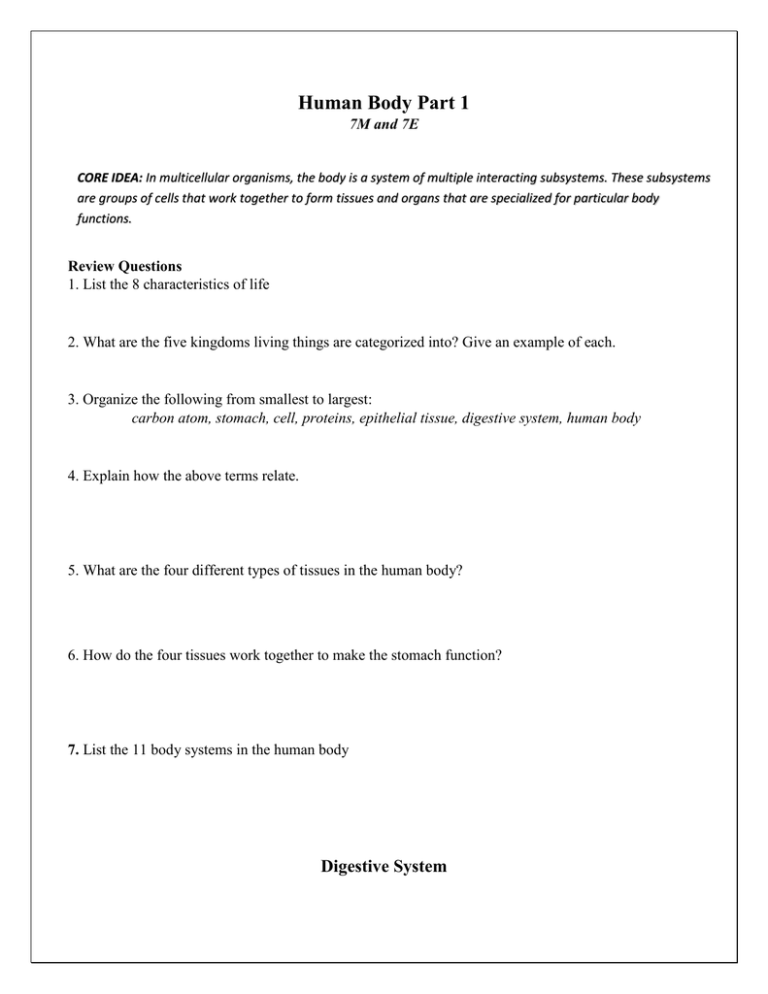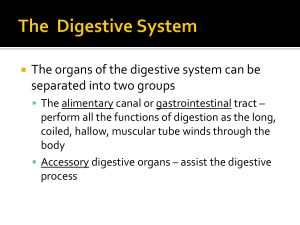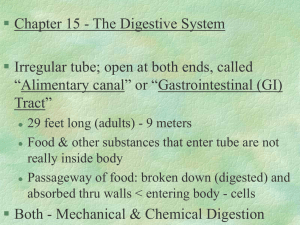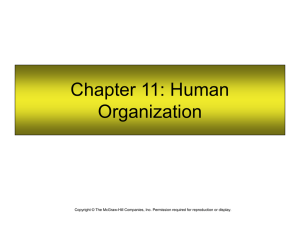Human Body Part 1 Study Guide - 7E and 7M
advertisement

Human Body Part 1 7M and 7E CORE IDEA: In multicellular organisms, the body is a system of multiple interacting subsystems. These subsystems are groups of cells that work together to form tissues and organs that are specialized for particular body functions. Review Questions 1. List the 8 characteristics of life 2. What are the five kingdoms living things are categorized into? Give an example of each. 3. Organize the following from smallest to largest: carbon atom, stomach, cell, proteins, epithelial tissue, digestive system, human body 4. Explain how the above terms relate. 5. What are the four different types of tissues in the human body? 6. How do the four tissues work together to make the stomach function? 7. List the 11 body systems in the human body Digestive System Organs and Structures – Relevant Vocabulary know location and function oral cavity tongue pharynx (throat) esophagus stomach small intestine (villus) large intestine (colon) rectum anus appendix salivary glands liver gall bladder pancreas sphincter epiglottis mechanical and chemical digestion nutrients absorption elimination chyme enzymes hydrochloric acid (HCl) calories (energy) macromolecules (protein, fats, and carbohydrates (sugars and starches)) fiber peristalsis bolus capillaries villus bile bile duct Enzymes: pepsin amylase lipase Review Questions 1. What is the function of the digestive system? 2. Why do we have to eat? 3. What is the difference between the GI track and accessory organs? What structures belong to each? 5. What is the importance of mechanical digestion and where does it take place? 6. Distinguish between mechanical and chemical digestion? 7. Fill out the chart Macromolecule Location of chemical breakdown Enzyme that breakdown molecule Carbohydrates Protein Lipids 9. What are three things your tongue does for you? 10. How does bile help in lipid digestion? 12. What are the similarities and differences between the small and large intestine? Small Intestine Similarities 13. How is the small intestine structured to increase surface area? 14. How does food travels through the digestive track. Respiratory System and Cellular Respiration Organs and Structures – know location and function Relevant Vocabulary Large Intestine nasal cavity pharynx –throat larynx- voice box trachea – windpipe epiglottis bronchi bronchioles alveoli alveolar sac lungs diaphragm nostrils cilia vocal cords breathing inspiration/expiration (inhalation/exhalation) respiration oxygen O2 carbon dioxide CO2 oxidation anaerobic aerobic glucose Review Questions: 1. What are the two jobs of the respiratory system? 2. What are the three jobs done by the blood vessels, cilia, and mucus in your nasal cavity? 3. Why is it better to breathe through your nose instead of your mouth? 4. Why does your trachea need to have cartilage rings? 5. How does the oxygen you bring into your body get into the circulatory system? (use diffusion in your response) 6. What position must the diaphragm be in when you inhale? Exhale? 7. How do the terms breathing, circulation, and respiration relate? 8. Explain how oxygen gets from the air we breathe to our cells. 9. What is the difference between anaerobic and aerobic respiration? Give an example of an organism that does each. 10. Fill out the chart below about cellular respiration Who What Where Why When 11. Write out the balanced chemical equation for cellular respiration? 12. Label the reactants and products. 13. How many atoms are in the reactants? ________Products? ________Show your work. 14. Where is the energy stored? 15. Explain how matter cannot be created or destroyed, but only rearranged through chemical reactions. 16. Describe how the respiratory and digestive system work together to help humans survive.











